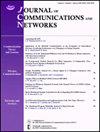FTN-GFDM detection based on reduced-complexity soft sphere decoding integrated with polar codes
IF 3.2
3区 计算机科学
Q2 COMPUTER SCIENCE, INFORMATION SYSTEMS
引用次数: 0
Abstract
In remote rural areas, it is not possible to employ massive multiple-input multiple-output (MIMO), small cells, and ultra-dense networks (UDNs) with the aim of increasing throughput. A solution is to improve the waveform spectral efficiency, integrating faster than Nyquist (FTN) signaling with generalized frequency division multiplexing (GFDM). However, this presents high self-interference in the time and frequency domains, requiring dedicated detectors for performance loss mitigation. Hard decision detection schemes primarily designed for MIMO have been adapted to detect FTN-GFDM signals without degradation of the uncoded bit error rate (BER), but these schemes are suboptimal in terms of capacity as they do not provide all the information contained in log-likelihood ratios (LLRs). We design and evaluate in this paper a soft sphere detector (SD) algorithm for FTN-GFDM that can be integrated with state-of-the-art forward error control (FEC) decoders for good BER performance over mobile channels. The SD detector is combined with polar codes, and the BER and complexity are evaluated for different channel models. The results show that FTN-GFDM can provide high spectrum efficiency gains without significant coded BER losses and with affordable complexity on the receiver side, which makes this waveform an interesting candidate for mobile networks in remote areas.基于与极地编码集成的降低复杂度软球解码的 FTN-GFDM 检测
在偏远的农村地区,不可能采用大规模多输入多输出(MIMO)、小蜂窝和超密集网络(UDN)来提高吞吐量。一种解决方案是提高波形频谱效率,将快于奈奎斯特(FTN)信令与广义频分复用(GFDM)整合在一起。然而,这会在时域和频域产生较高的自干扰,需要专用的检测器来减少性能损失。主要为多输入多输出(MIMO)设计的硬决策检测方案已被用于检测 FTN-GFDM 信号而不会降低未编码误码率(BER),但这些方案在容量方面并不理想,因为它们不能提供对数似然比(LLR)中包含的所有信息。本文设计并评估了一种用于 FTN-GFDM 的软球检测器(SD)算法,该算法可与最先进的前向差错控制(FEC)解码器集成,在移动信道上实现良好的误码率性能。SD 检测器与极性编码相结合,并对不同信道模型的误码率和复杂性进行了评估。结果表明,FTN-GFDM 可以提供较高的频谱效率增益,而不会造成显著的编码误码率损失,接收器端的复杂度也在可承受范围之内,这使得这种波形成为偏远地区移动网络的理想候选波形。
本文章由计算机程序翻译,如有差异,请以英文原文为准。
求助全文
约1分钟内获得全文
求助全文
来源期刊
CiteScore
6.60
自引率
5.60%
发文量
66
审稿时长
14.4 months
期刊介绍:
The JOURNAL OF COMMUNICATIONS AND NETWORKS is published six times per year, and is committed to publishing high-quality papers that advance the state-of-the-art and practical applications of communications and information networks. Theoretical research contributions presenting new techniques, concepts, or analyses, applied contributions reporting on experiences and experiments, and tutorial expositions of permanent reference value are welcome. The subjects covered by this journal include all topics in communication theory and techniques, communication systems, and information networks. COMMUNICATION THEORY AND SYSTEMS WIRELESS COMMUNICATIONS NETWORKS AND SERVICES.

 求助内容:
求助内容: 应助结果提醒方式:
应助结果提醒方式:


